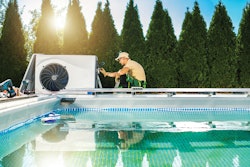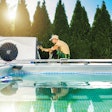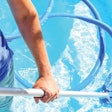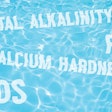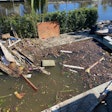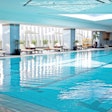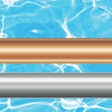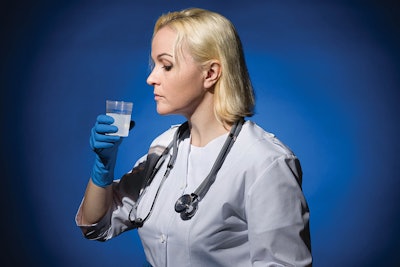
There are a number of well-known sayings or just prevalent ideas about water care and maintenance, little things we’ve probably heard a few times over the years as to whether something works or doesn’t work when you’re treating pool and spa water.
Some of them are true, but many are not.
This article sorts through some of the most popular, and precipitates water treatment fact from some of the pure fancy in which fact is often dissolved.
Before we begin, I want to address a popular misconception in many parts of the country. This is not one of the official myths, but you’ve probably heard it:
There is no special chemical that you can add to the pool that will magically turn colors next to the little kid who just peed in the pool.
(Actually, this is one of those myths we might want to perpetuate — for the sake of proper pool hygiene. So maybe we’ll keep that one around.) Okay, on with the show.
MYTH NO. 1: AN EXPERIENCED OPERATOR CAN JUST TELL WHETHER POOL OR SPA WATER IS GOOD OR NOT, JUST BY LOOKING AT IT.
Well, that’s kind of true and mostly not. Actually, when you approach a body of water, a pool or spa, you’re going to use four of your five senses.
First, you’re going to listen for any sounds, for example. We all know what a normal filter sounds like and what a pump should sound like. If you walk into a customer’s backyard, and you suddenly start hearing noises you’ve never heard before, then that’s a signal that something may be wrong.
Secondly, you are going to use your sight because you’re going to take a visual check around the pool. You’ll check the decking, check the water — whether it’s clear or cloudy — make sure there’s no visible algae or cracks or rust spots or scaling or things of that nature on the pool walls. You’re going to see if there’s a problem.
Also, you’re going to use your sense of smell. If you walk up to a pool, and you smell chlorine very strongly, guess what? You’re not smelling the good kind of chlorine, you’re smelling the bad kind of chlorine — combined chlorine. So using your nose is also critical.
And finally, you’re going to use your sense of touch. If you see a stain, for example, on the side of a pool, and you can reach it with your hand and feel it, you can tell something about it. If it’s smooth, if it has the same consistency and feel as the wall of the pool or spa, it’s probably some form of algae. If it feels rough, then it’s probably scale. It could be metals in the water attaching themselves to the wall.
The only sense you’re not going to use is your sense of taste. Please don’t drink the pool water or spa water. Believe it or not, there really are people who will actually do that.
MYTH NO. 2: A SPA IS JUST A LITTLE POOL.
In the sense that it holds water, that’s true. But a spa is not just a little pool. There are all sorts of issues that are particular to hot water environments — spas, hot tubs, jacuzzis, whatever you want to call them — that require a different approach than pools.
First, we’re dealing with higher temperatures. The maximum spa temperature is 104 degrees Fahrenheit. Anything higher is considered a potential health hazard for women who may be pregnant. And for very small children, it’s not a good idea to sit in hot spa water.
Second, we’re also talking smaller volumes, and when we’re talking smaller volumes of water, we’re also talking smaller treatment amounts. This is why we sometimes call it teaspoon chemistry.
Third, with spas, we have jetted water which you don’t normally have in a pool. Yes, I know there are swim spas and pools that have jets that allow you to swim against resistance, but that’s a little bit different.
With spas and jetted water, although it feels great on your back and your muscles, it can also cause some problems when it comes to testing and treatment. Jetted water can actually increase the pH of your spa because it produces hydroxides (OH-), and that will push pH up. So, you have to be careful about that, and you wouldn’t normally have that in a regular pool water environment.
Fourth, we have a higher bather load ratio in smaller volume situations than we would in a pool. Four people in a 400-gallon spa is roughly equivalent to 250 people in a 25,000-gallon pool. Think about that for a second. It’s a little sobering.
Because of high bather loads in smaller bodies of water, you have the potential for chemical issues, sanitation issues, and calcium hardness.
(Calcium, by the way, is an unusual mineral that actually loves hot water and will come out of solution to scale and cloud quickly in hot water. So, the hotter the water, the more calcium wants to form scale deposits on the walls of the spa, whereas with that same calcium concentration in pool water with lower temperatures, you wouldn’t see that.)
And then finally, a big difference between pools and spas is the ability to replace old water with fresh water. This is relatively easy to do in a spa environment because of the smaller volume, but not so easily done with large pool volumes, for obvious reasons.
So, you can see that just because a spa holds water like a pool does, it is still a unique situation which must be treated differently. So that myth is busted.
MYTH NO. 3: TESTING SUPPLIES ARE A COMMODITY.
There is certainly a myth in some people’s minds that testing supplies are a commodity, and therefore, a wise buyer shops on price and price alone.
In fact, there are differences in products, whether it’s a chemistry test, a test strip, something digital, electronic, or whatever. Here are some aspects to look at when judging a water testing product.
First of all, is the test system easy to use? Are the instructions clear and complete? Are they understandable? Are they written so that pretty much anybody can follow them?
Is the kit complete? Does it have all the tests that you need to do in order to make sure that your customer’s pool water is in good condition?
You want to make sure that the test system is accurate and consistent. And by consistent, I mean you want to get the same answers every time you test the same water. You don’t want to see odd jumps in values. If you’re testing the exact same water over and over, and getting different results, that should tell you something about your test. Everyone should be aware that you can actually test your test kit. There are things called standard solutions that come from a lab that can confirm specific values and properties in water that you can test to make sure your test kit is working fine.
So, for example, there’s a standard solution for total alkalinity at 100 ppm, hardness at 200 ppm, pH at 7.2, and cyanuric acid (CYA) at 50 ppm. These are easily available from any test kit manufacturer. Unfortunately, there’s not a standard solution for chlorine or bromine because they dissipate out too fast. So, I usually tell people that if they want to verify their chlorine test procedure, use tap water — particularly if your tap water is from a municipal system — because it’s a public facility so you can always check to see what the chlorine level is that particular day. They usually place their information on some kind of a public access website.
And finally, one last important aspect of a good test kit: availability. If you need replacement pieces, reagents, test strips, tablets, whatever, can you easily get those replacement supplies from your local supplier? Sometimes it’s difficult.
Sometimes there are shortages. You want to be able to buy your testing supplies or systems easily from a reliable source. Whether that source is a distributor or pool and spa retailer, it doesn’t really matter, but you want to make sure that you’re able to get those products when you need them.
Again, busted.
 Pool steps are a poor location to take a water sample.Photos courtesy Taylor Water Technologies
Pool steps are a poor location to take a water sample.Photos courtesy Taylor Water Technologies
MYTH NO. 4: IT DOESN’T MATTER HOW YOU USE TEST STRIPS AS LONG AS YOU GET THEM WET.
Well, the problem here is that for those of us who do manufacture test strips, all of our instructions are a little bit different. Some people will say dip the strip up and down. Others will say do it in a circle. Others will say swish it back and forth. Others will say, when you remove the test strip, hold it vertically.
Some say hold it horizontally. Some say don’t let the water drip from pad to pad. Others say it doesn’t matter. So, you really can’t say a test strip is a test strip, and I’m going to use them all the same way, because they’re not.
You need to follow the instructions in order to make sure that you’re getting the best possible results from that test strip.
So, put that myth in the trash with the others.
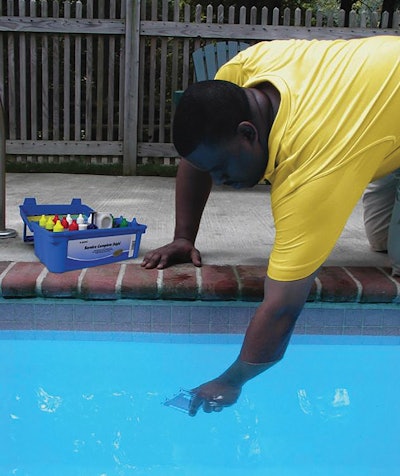 Collect a water sample by going below the surface up to your elbow in order to obtain more accurate results.
Collect a water sample by going below the surface up to your elbow in order to obtain more accurate results.
MYTH NO. 5: YOU CAN TAKE A WATER SAMPLE FROM ANY LOCATION IN THE POOL.
This one is just flat wrong.
Take a look at the picture above. The man in the picture is going down to about elbow length into the water in order to collect a sample. That’s the correct way of doing it. You can’t collect or test water along the surface. Sunlight can penetrate 4 to 6 inches into water, and that affects chemistry and can give you false readings. That’s why you need to go 18 inches down or to the bend in your elbow to collect your sample.
Also, you want to collect it away from the return line because that return line could contain concentrated amounts of a treatment chemical that could affect your overall test results — like maybe acid, if you have an acid feed system, or some other kind of product that’s being fed into the pool that can really mess up test results.
So, you can’t just simply take it from any location in the pool. You have to go 18 inches down, and away from a return line. In an ideal world (and I know this is never going to happen, nobody has time to do this), you should take a sample from the shallow end, a sample from the deep end, and take the average of the two results.
I usually go to the point where the pool just starts to slope down into the deeper end, checking to make sure there’s no return line coming back in. And that’s where I collect my sample.
Some very ambitious people like to go out and lay down on a diving board on their stomachs and collect the sample that way, and I applaud their enthusiasm, but let’s be realistic.
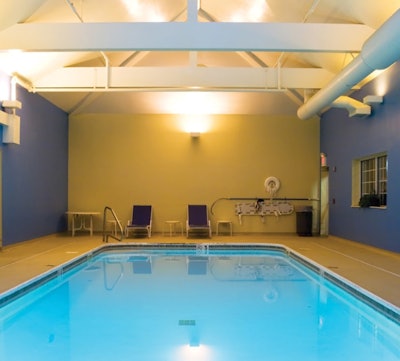 Fluorescent lighting is just about the worst kind of lighting you can use to match colors.Photos courtesy Taylor Water Technologies
Fluorescent lighting is just about the worst kind of lighting you can use to match colors.Photos courtesy Taylor Water Technologies
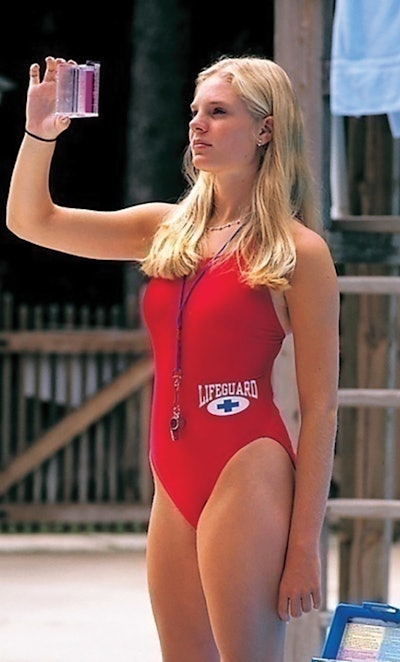 Hold the strips or vials or comparator at eye level, perpendicular to the ground, with back to the sun. And take off those sunglasses!
Hold the strips or vials or comparator at eye level, perpendicular to the ground, with back to the sun. And take off those sunglasses!
MYTH NO. 6: TESTING INDOORS OR OUTDOORS, IT’S ALL THE SAME.
Actually, no, it’s not.
Colors look different under different lighting conditions. Outdoors, the ideal position is facing north with the sunlight on your back, holding the strip at eye level and perpendicular to the ground. You don’t want to be facing the sun because it can actually alter how your eyes interpret that color.
And take off those sunglasses because even the most inexpensive dollar-store sunglasses have a degree of polarization to the lenses that can change the spectrum of light as it comes through the lenses to your eyes. Just slip off the sunglasses, give your eyes a second or two to adjust, then go ahead and do your testing.
What do you do at night? Well, try to avoid fluorescent lighting. That’s just about the worst kind of light to use when you’re trying to match color because fluorescent lighting and LED lighting actually can affect how your eyes interpret color. Blue can look black in fluorescent light.
Indoors, without direct natural light on the pool, you have some options. If it’s indoors and during the day, get outside, go to a window, go outside and do the test.
If you’re at an indoor pool at night, what do you do? Well, you have two options. One, you can consider using a daylight simulating lamp, much like makeup mirrors that you might have seen in department stores. They simulate natural daylight versus evening light.
But if you can’t afford one of those, then you have to work with what you have. And if there are no good options indoors, what I would recommend is testing all the time in the same position or the same location. So that at least you’re consistent in your possible inconsistency. If you get what I mean. Now you’re adjusting chemistry using consistent data.
These are actually just a few of the myths about water testing, but they are among the most prevalent. Some other misconceptions you may encounter include:
- "OT is superior to DPD for testing chlorine.”
- “A strong chlorine smell and red eyes mean too much chlorine.”
- "The effectiveness of a reagent primarily depends on how old it is.” and many others, but we’ll leave that for another day.
Wayne Ivusich (soon to be retired after a long and illustrious career in the pool and spa industry) is manager of education and technical services, Taylor Water Technologies, Sparks, Md.
This article first appeared in the June 2022 issue of AQUA Magazine — the top resource for retailers, builders and service pros in the pool and spa industry. Subscriptions to the print magazine are free to all industry professionals. Click here to subscribe.





















